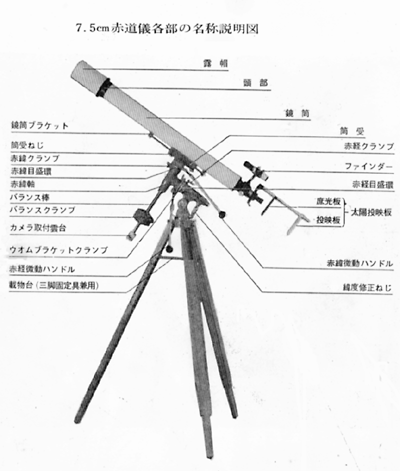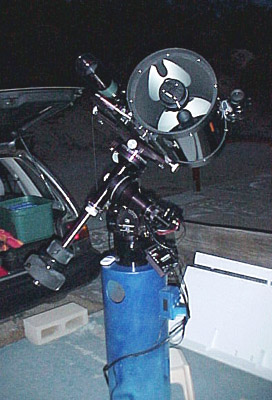|
Phase I (the 60's)

After months of lusting after the neat Unitron scope ads, I managed to get my first real telescope -- a Goto Optical (or "Gotoh", the company, not go-to) 3", F15 refractor mounted on a clock-driven equatorial mount. I managed to get this on a family trip to Japan with the help of my uncle, an engineer. He took me to the Goto Optical factory and made sure I had all necessary pieces to make the mount work in Hawaii. The Goto company appears to have since gotten out of the amateur instrument market. For photography I used a Canon Pellix 35mm camera. Since very limited choices were available for films, I used Kodak Tri-X 35mm film, which I learned to develop and print myself after one experience with a confused local processor. However, I really never got past photographing the moon and other very bright objects. 
Phase II (the early 90's) After a long interval away from astronomy due to school, a move to Southern California, and my early working career, and triggered by my "discovery" that the largest amateur astronomy club is located in Orange County, CA (The Orange Country Astronomers - OCA), I got back into things with a Celestron CG-11 system. A few years later, I managed to even get my own permanent observing pad at the OCA's Anza observing site. After finding out the hard way about the difficulties of doing photography with an SCT (long focal lengths, slow f-ratio, off-axis guiders, field curvature distortions, etc), I got a 70mm Pronto and experimented with wide-field photography. By this time advancements in film had been considerable, and I settled on mainly using Kodak Ektachrome Elite II slide film since the problems of printing astrophotos could be bypassed with slides. On objects of wide dynamic range I used Kodak PPF 400 negative film. Late in the 90's I also invested in a 35mm film scanner - a Nikon LS-1000. The Pronto served me well, having traveled with me to the 1999 solar eclipse in Turkey, but I've since concluded that it is not really suited for photography, and especially travel photography, due to its weight and optical performance. See my phase III discussion to see the Borg 76ED which replaced it. Photographically, the C11 turned out to be difficult to use because of the number of simultaneous hurdles to overcome. For the moment, I plan to work at shorter focal lengths for aesthetic reasons (I like wide field shots) as well as for reasons of less difficulty, but in the future I plan to graduate back up to it for long focal length photography. |


